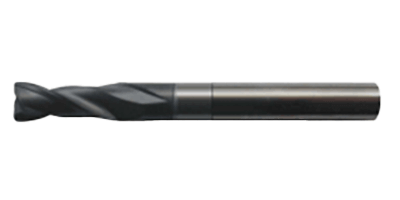What Is a Diamond End Mill?

A diamond end mill is a cutting tool that employs diamond as its cutting-edge material.
Diamond possesses exceptional hardness and heat diffusion properties, making it an ideal choice for cutting tool material. Over 80% of natural diamonds are used in industrial applications, and the majority of synthetic diamonds are produced artificially. Synthetic diamonds, also known as lab-grown diamonds, are artificially created from carbon and other materials.
Diamond end mills exhibit remarkable longevity when machining materials like graphite, Carbon Fiber Reinforced Plastic/Glass Fiber Reinforced Plastic (CFRP/GFRP), ceramics, and more.
Uses of Diamond End Mills
Diamond end mills can create “sharp cutting edges” when their cutting edges are ground. These cutting tools leverage diamond’s properties to enable ultra-precise, exceptionally long-lasting, and high-performance machining.
Diamonds used in cutting tools are categorized as monocrystalline and polycrystalline diamonds, with monocrystalline diamonds further divided into natural and synthetic diamonds.
Monocrystalline diamonds are known for their high hardness, excellent heat diffusion, and sharp cutting edges. In contrast, polycrystalline diamonds are composed of small single crystals oriented in various directions. This irregular structure makes them resistant to force from any direction, and they are characterized by their durability and resistance to chipping and delamination.
Principles of Diamond End Mills
Diamond end mills are cutting tools that can be mounted on machining centers and milling machines. They are well-suited for machining nonferrous metal materials such as aluminum alloys and copper alloys, as well as non-metallic materials like wood, plastic, and molded ceramic materials.
It is advisable to avoid machining ferrous materials due to their affinity for iron. Additionally, diamond end mills have low toughness, so machining with impact should be approached with caution.
In various industries such as machinery and electronics, there is a growing trend towards higher efficiency and precision in cutting. This has led to the increased adoption of diamond tools. For instance, in the automotive industry, the use of diamond tools has been rising due to the need for highly efficient machining to enhance productivity and the increased utilization of aluminum alloys to reduce vehicle body weight.
Sintered diamonds, produced by hardening diamond powder under ultra-high pressure and high temperature, possess high hardness and toughness, making them widely used as cutting tools and wear-resistant components.
Recent years have witnessed a surge in demand for diamond tools as machining becomes more efficient and precise, and materials become increasingly diverse and challenging to machine.